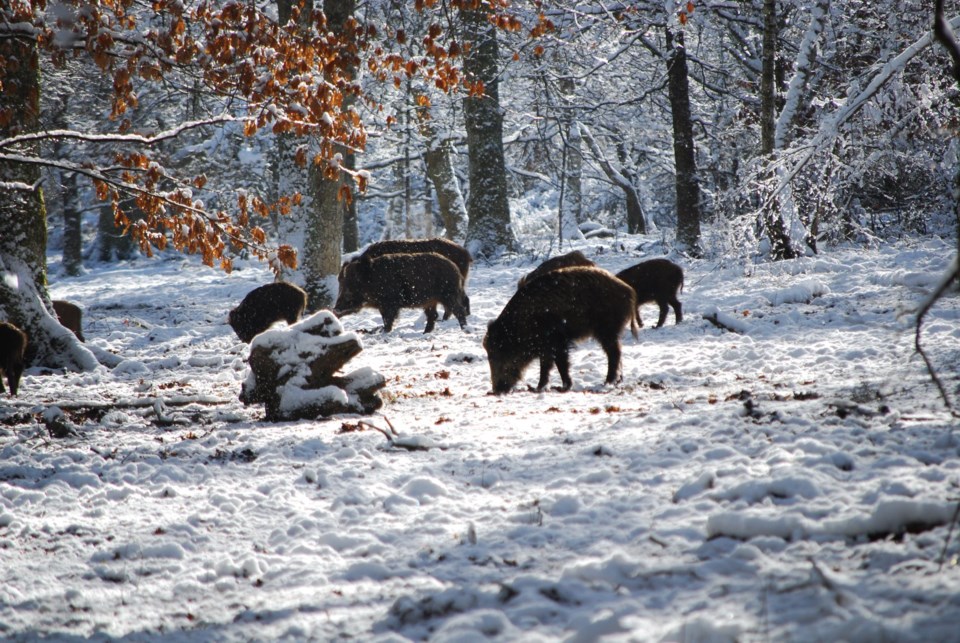WATERLOO REGION — Anyone who wants to help root out wild pigs in Ontario before they become established can now access some instructions on how to do it.
The Ontario Federation of Anglers and Hunters has developed a protocol of best practices for trail camera use to help hunters or anyone with a trail camera be prepared to spot wild pigs in their area.
The Ontario Federation of Anglers and Hunters developed the protocol last year through a literature review of the trail camera methods used in wild pig research to find the common scientific best practices. They published their work in a two page infographic handout available on their website.
“A really good analogy for wild pigs is a fire. If you see smoke, or see a spark, you want to deal with that right away and not let the problem get bigger because then it gets a lot more tricky to deal with,” says Keith Munro, wildlife biologist with the Ontario Federation of Anglers and Hunters.
“What we’ve seen is a real interest and desire to help among our members and the hunting community at large to help keep Ontario wild pig free.”
The trail camera protocol outlines best practices on where to place cameras, how to bait them, the settings needed and what to do if a pig is spotted.
Munro says people should set their cameras up near any signs of wild pigs to confirm their presence.
Typical pig signs include wallows where pigs have been rolling in mud to keep cool (because they don’t sweat), or rooting marks in the ground where they’ve been tearing up the earth with their snouts. The handout also illustrates the difference between deer and pig tracks.
If no signs have been seen, Munro advises people to set their cameras up in areas used by other animals like deer trails, or within wetlands, forests, the edges of crop fields and water sources.
The handout also goes over best baiting practices including how far to set the camera away from the bait, and also what kind of bait to use to ensure pigs are targeted rather than other animals like deer. Munro says bait can be a problem for deer because there are certain foods they cannot eat in certain seasons.
Other information covered includes which direction to face the camera and trimming vegetation so the camera won’t be triggered by the sun or leaves.
“We distilled a lot of information into this document,” says Munro.
“I think an important point is that very often people will set their cameras up and not detect pigs, and that’s a good thing,” he says. “The goal is to not detect any pigs. The goal is to say, we did a good job and we looked and there’s no pigs there, and be confident in that.”
“But if we do get pictures of pigs, not only can we ensure that they get removed, but it will also be helpful for future communications because we have those videos we can use.”
Anyone who sees a wild pig or signs of one, is encouraged to call the invasive species hotline which is a collaborative project between the Ministry of Natural Resources and Forestry and the Ontario Federation of Anglers and Hunters.
In Ontario, all wild pigs at this point appear to be recent escapees, says Munro. Unlike Saskatchewan and the United States, Ontario does not yet have an established, self-sustaining wild pig population.
Statistics Canada estimates 14 million hogs in the country as of Jan. 1, 2021, which is an increase of 0.4 per cent from last year.
Ontario Pork estimates 5.8 million hogs were marketed in Ontario in 2020, with the Huron, Perth and Oxford associations leading the province. The Waterloo Association ranks seventh with over 257,000 hogs.
The Ontario Ministry of Agriculture, Food and Rural Affairs has published recommendations for fencing standards, and the province has proposed adding wild pigs to the Invasive Species Act, though this has not yet been finalized.
Since January 2020, wild pig researchers have investigated 25 locations in southern and eastern Ontario, where 81 sightings of wild pigs were reported, according to Jolanta Kowalski, a spokesperson for the Ontario Ministry of Natural Resources and Forestry.
The ministry keeps track of sightings on its dedicated iNaturalist page.
Pigs are the fastest reproducing mammal of their size. They reach sexual maturity in six months and have litters twice a year, with around 10 piglets per litter. In Ontario, a wild pig can weigh up to 420 pounds.
They root up the earth with their strong necks, tusks and snouts, causing a lot of damage to the landscape, and even water quality. Pigs are omnivores and will eat almost anything. They not only compete with native species and livestock for foliage and feed, they may also attack and eat them.
The United States Department of Agriculture estimates more than $1.5 billion is lost each year to wild pigs either through damage, prevention measures or lost agricultural produce.
“We really know the potential negative impacts of wild pigs and we can see that from the Prairie provinces and we can see that from the United States too. We’re at the point in Ontario where with a little bit of effort we can keep ourselves from getting to that point,” says Munro.
Wild pig sightings can be reported to the Invasive Species hotline at 1-800-563-7711.
Leah Gerber’s reporting is funded by the Canadian government through its Local Journalism Initiative. The funding allows her to report on stories about the Grand River Watershed. Email [email protected]
